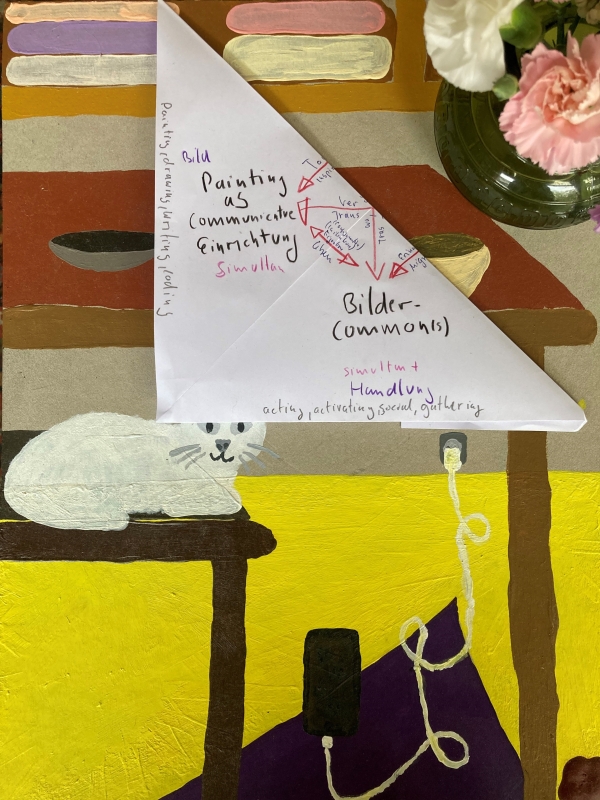Painting as communicative Einrichtung - Bilder-Commons - Image Constellation
Panel by Philipp Schwalb
Abteilung
Malerei
In 1919, 103 years ago, Florine Stettheimer embedded her own paintings in the painting
Studio Party (Soirée) as furniture, as an integral and functional element of her salon practice in New York City. These relational
images supported the communication between guests, scenes, paintings, and other images, while exposing a contemplative, cognitive,
and interactive setting for a social figuration. A few years later, the art historian and museum director
Alexander Dorner commissioned El Lissitzky’s “Abstract Cabinet,” a room with a reduced, holistic, usable, and abstract design
dedicated to the relationality, presentability, and function of images. Visitors were allowed to change the position of some
of the paintings, thereby creating new constellations and experimenting with the flexible uses, different perspectives, and
changing meanings of artworks. Dorner was explicitly interested in the social and interactive components of artworks, their
relationships to each other, and to their surroundings. In 1974 Michel Asher removed the wall dividing a gallery’s office/storage
and the exhibition space. 4 years earlier Pierre Klossowski published La Monnaie vivante and developed the idea of a painting
as a coin with three sides. In Mind of My Mind (1977), Octavia E. Butler outlined the role of the artist as a telepathic medium
and art as a generator of psychedelic, emotional, and educational translations.
The hinge between these two passages is Painting as communicative Einrichtung, as a specialized form of painting
critical of institutions, as decorative picture, and as an arrangement for different conceptual/philosophical orientations.
Uff.
In 2020, 4 years ago, I embedded my own paintings in the painting Books(h)elf (Agnes
Martin) as furniture, as an integral and functional element of my exhibition, reading, and social practice in NYC. These relational
images supported the communication between peers, influences, paintings, and other images, while integrating a contemplative,
emotional, and physical setting for a social figuration. A few years later, I made the exhibition “Die Gift Born” as a display
dedicated to a reduced, associative, usable, and abstract narrative that exposes the relationality, presentability, and the
function of images. Most of the images were carefully treated and visible from two sides. Visitors were allowed to change
the position of the paintings, to create new constellations, and to experiment with the flexible uses, different perspectives,
and changing meanings of artworks. I was interested in the social and interactive components of the paintings, their relationships
to each other, and to their surroundings. This Image Constellation Panel (ICP) is located in the passage between studio and
public, between practice and theory, between aesthetics and anti-aesthetics, and is an instrument between exhibition, lecture,
mind-map, and discursive assembly. The ICP on May 13 2024 is about my methods, my paintings, four exhibitions, adjectives
that describe different ways of translation (into painting), Painting as communicative Einrichtung, and Bilder-Commons.
Philipp Schwalb lives and works in Rotterdam as an artist, reader, curator,
and art educator. Since 2010 he has been experimenting with and questioning the animation of color and figuration in Bilder,
their communication, conditions, effects, and frameworks. Since 2008 he has been involved in several self-organized spaces,
exhibitions, labs, sessions, and conventions. In 2018/19 he organized the Geneva “Convention of more Sense in Leif + Lof 4
ALLe.” From 2017 to 2019, he was a visiting professor for painting at the Haute Ecole d'art et Design in Geneva. In 2022 he
co-organized and curated the “Mural Sessions” in Geneva. In 2022, he launched Bild as Commons. In 2023 he co-organized I/Economic
Sediments, a series of workshops for the collective creation of image constellation panels. He has exhibited or curated at
the following venues: Kirchgasse (Steckborn), New Toni (Berlin), Le Frac Lorraine, Kunsthalle Langenthal, Kunsthalle Marcel
Duchamp (Cully), Kunsthalle Basel, ZKM Karlsruhe, Kunstraum München, Villa Romana (Florence), David Castillo (Miami).




